The best winter cycling shoes are designed to solve the problem affecting most other cycling shoes. While summer cycling shoes are meant to keep your feet cool, which is great in the summer, they can make keeping them warm in the winter an almost impossible task.
It feels as though we have the same conversation every year: ‘How do I stop my feet getting cold in the winter?’. And while there’s an endless array of socks, overshoes and ingenious tricks that are claimed to help with cycling in the rain and cold, and to be able to put an end to your misery, for some people and conditions, none of these will even come close.
This is where the dedicated winter cycling shoe comes in.
Free of superfluous ventilation, roomy enough for thick, woolly socks and built with materials designed specifically to protect your feet from the elements, winter cycling shoes are the equivalent of a proper winter jacket for your feet. Once the cold weather comes around, we review a wide range for both road and off-road use.
We have also included our buyer's guide to winter cycling shoes below our product recommendations giving more detail on what to look for in your next pair.
Editor's note: this guide was reviewed and updated in February 2025.
Best winter cycling shoes 2025, as rated by our expert testers
Lake CX146

- £200 / $280 / €249 as tested
- Cleat type: Road cleats
- Pros: Great protection from rain and cold; large size range; wide fit
- Cons: Bulky; firm against shins
While many winter boots opt for a low ankle cuff, Lake's are much higher, which means a lot less water ingress. They're made of leather, which is DWR-coated to prevent wetting out, with a membrane and Thinsulate insulation underneath and a double insulation layer at the toe box. There's a fibreglass-reinforced nylon sole too.
There's impressive wet and cold ride performance, although the downside of the heavy-duty design is a stiff feel and a weight of over 900g a pair in size 45. The pricing of the Lake CX146 shoes is competitive and there's a large size range, including a wide fit.
SQUIRREL_13184149
Leatt 7.0 HydraDri
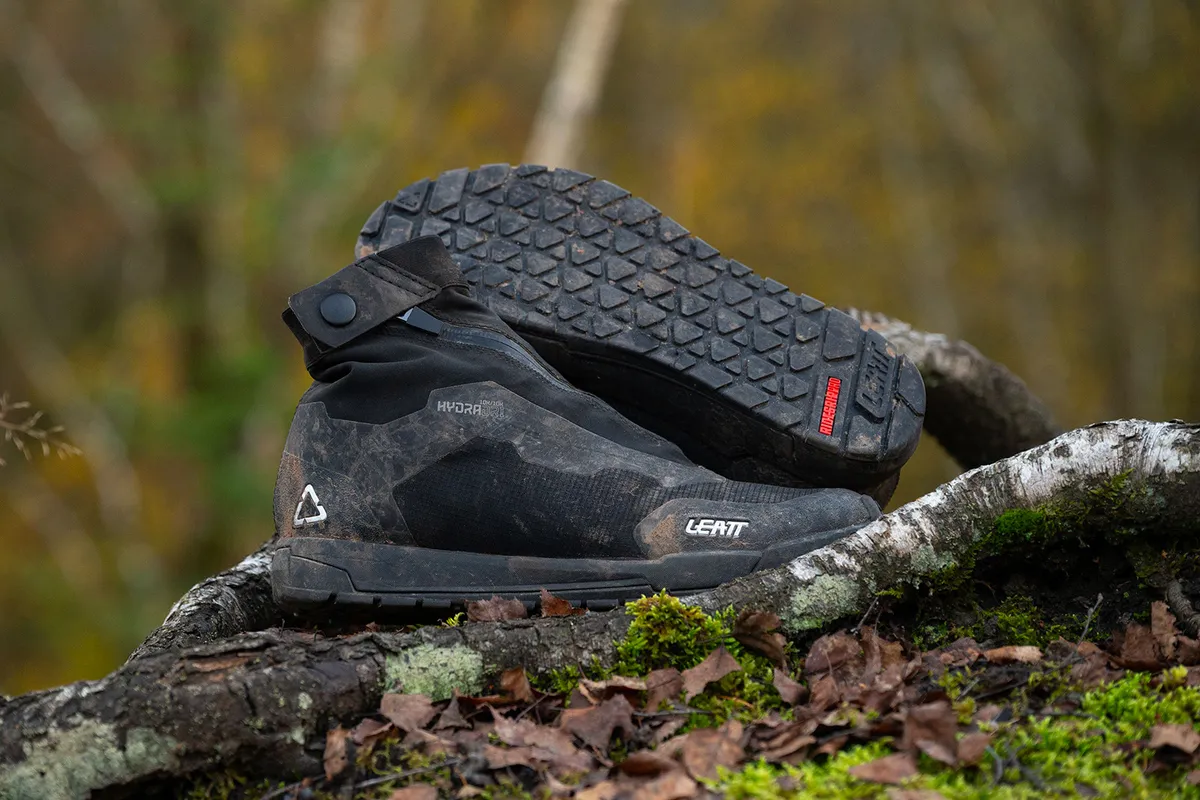
- £190 / $190 as tested
- Cleat type: Flat pedal
- Pros: Impressive comfort; good breathability; keep water out
- Cons: Could be lighter
Leatt’s new winter flat shoes offer impressive comfort, thanks to their true-to-size fit and cosy insulation. That makes them good for colder, not just wet, weather.
While the HydraDri liner doesn’t offer the same waterproof and breathability ratings as Gore-Tex, the zipped-up boot design does a credible job of keeping water out, and our feet remained dry during testing.
The speed-lace system is tucked inside the waterproof zip, keeping it clean, and offering a secure and snug fit.
Not only does the cuff extend a good way up, but, with its elastic opening and popper fastener,
it fits close to the ankle and tucks neatly under riding pants.
There’s plenty of bite from Leatt’s RideGrip Pro outsole, which keeps your feet attached securely to the pedals. The mid-sole balances stiffness and comfort well, and we never felt any harsh feedback.
A bonus is the Active Carbon insole, claimed to be anti-bacterial, anti-odour and quick-drying.
SQUIRREL_13188982
Scott MTB Heater Gore-Tex
SQUIRREL_TEXT_13095058
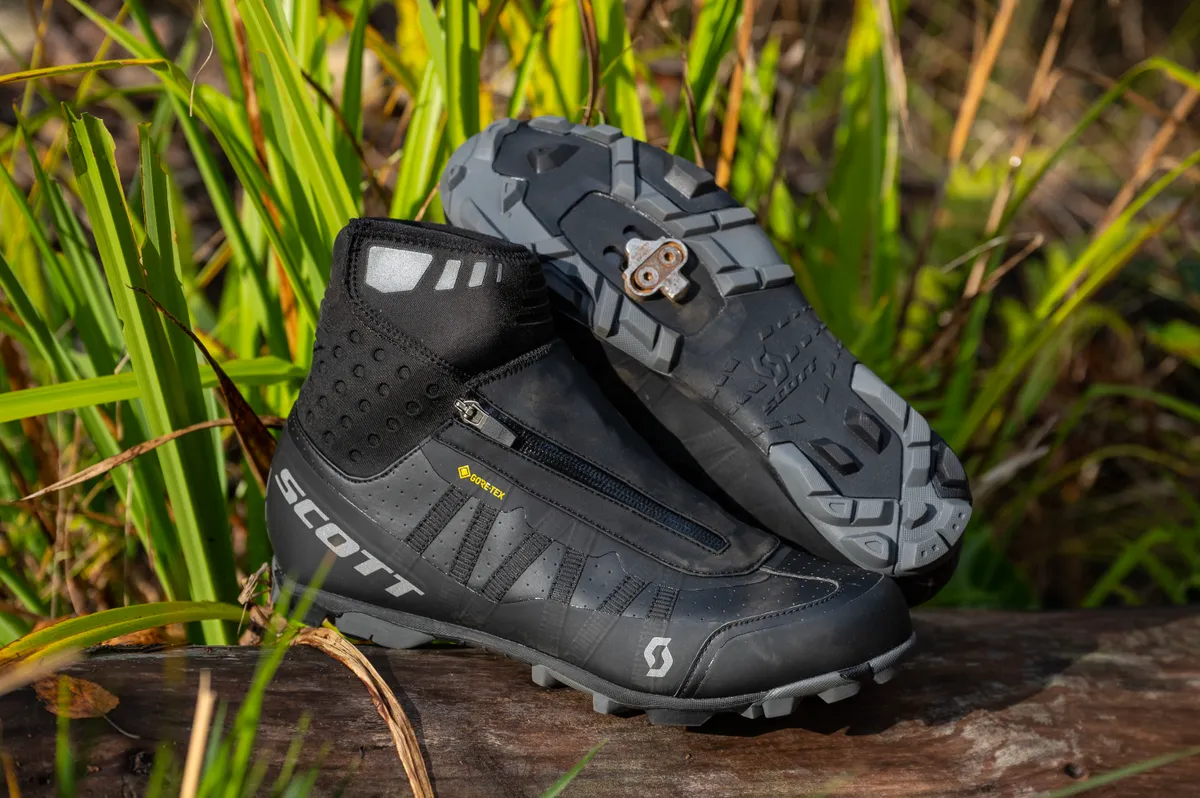
- £219.99 / $229.99 / €229.90 as tested
- Cleat type: MTB cleat
- Pros: Warm with good breathability; excellent in wet and submerged conditions
- Cons: Can feel bulky around the ankle; take a long time to dry
Scott's Heater boots offer neutral proportions that weren't too tight or roomy on our tester's foot, allowing enough room for the type of thick socks needed for winter riding.
Though slightly bulky, the insulation makes the boot warm enough for the majority of what winter has to offer, and a neoprene cuff helps the shoe stay dry when submerged.
These have become our tester's winter shoe of choice for mountain biking.
SQUIRREL_13095058
DMT WKR1

- £270 / $350 / €249 as tested
- Cleat type: Road cleat
- Pros: Low weight; comfortable; stiff sole
- Cons: Chilly when it gets properly cold; expensive
At 517g for a pair of size 45s, the DMT WKR1 shoes would be light for a summer shoe. They're based on a high-cuff, 3D-knit gravel shoe, with a DWR-coated, fleeced softshell skin placed over it. The sole unit feels stiffer than the winter boot competition.
The low weight is great for higher-intensity rides and there's good water resistance, thanks to the tight ankle cuff. There's less insulation than in many rivals though, so your feet get cold more quickly unless you add thicker socks – fortunately, the stretchy knitted uppers allow room for these.
SQUIRREL_13178093
Endura MT500 Burner Clipless
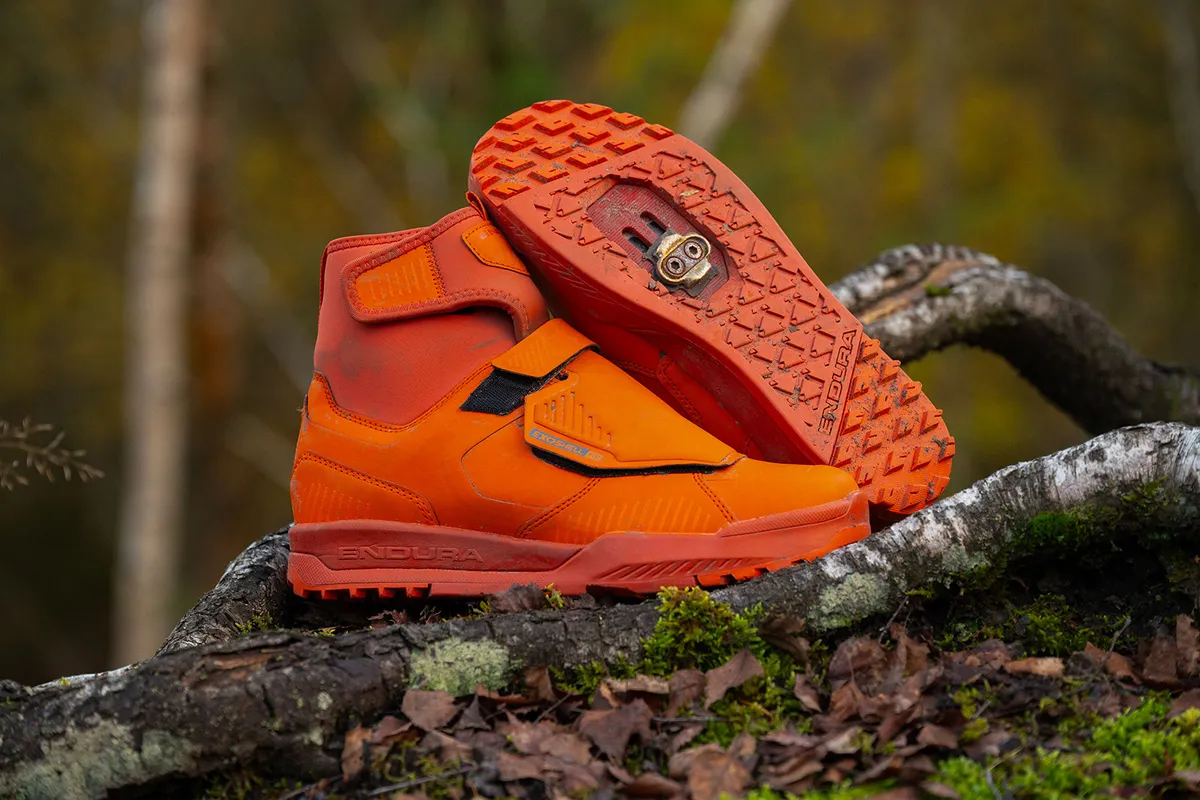
- £170 / $200 / €190 as tested
- Cleat type: MTB cleat
- Pros: Good waterproofing; high levels of heat retention without insulating layer
- Cons: Not as comfortable as others
Endura’s robust boots can handle the worst weather. The synthetic upper shrugs off puddle splashes and light rain, while the ‘ExoshellFW’ membrane kept our feet dry on wet rides.
While there isn’t a specific insulating layer, the liner, padding and outer offer moderate warmth on colder days.
The speed lace system covers the top of the foot, aided by a Velcro strap, and provides good retention of the shoe.
There’s a flap covering the laces, to help keep them clean. Getting the shoes on and off is easy, and the cuff is adjustable and tall. The sole is stiff, but offers decent comfort and shock absorption.
Setting up the cleats took longer than with other shoes here, but we clipped in and out easily once done. The cleat pocket has enough setback for DH riding.
SQUIRREL_13078755
Five Ten Trailcross GTX
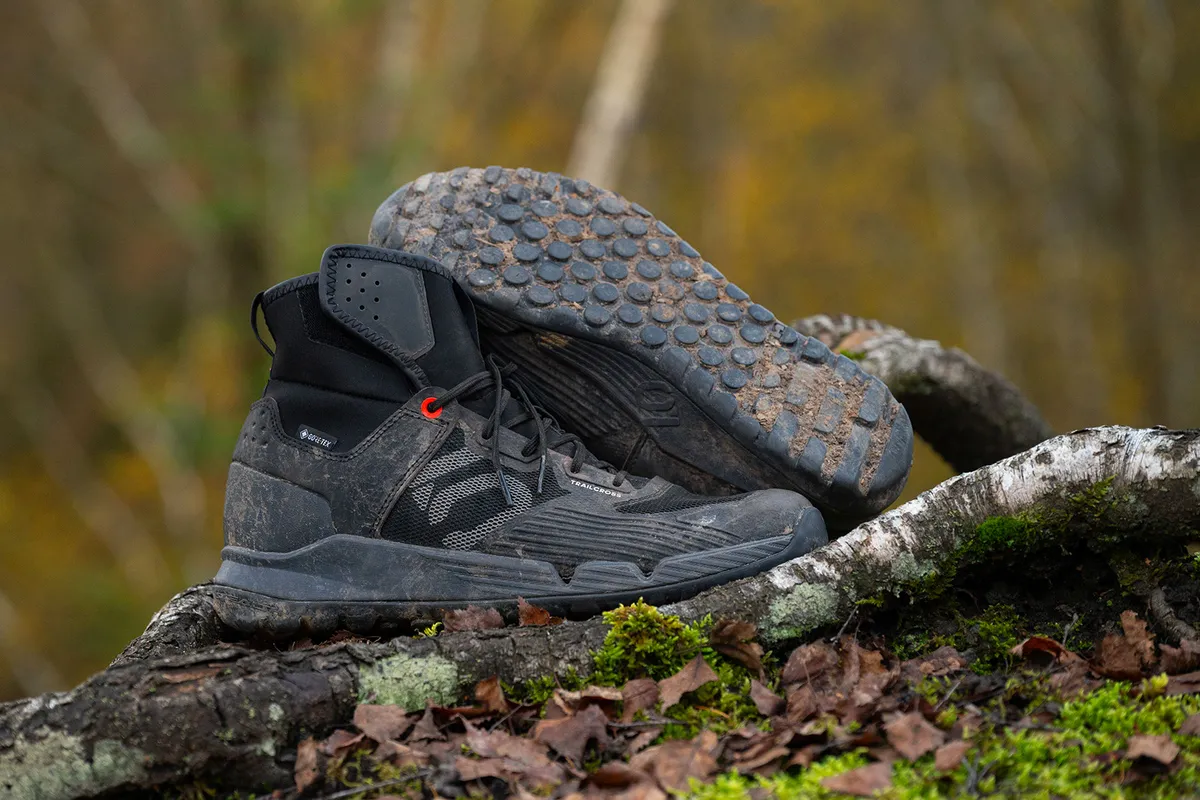
- £160 as tested
- Cleat type: Flat pedal
- Pros: Good comfort; high levels of grip
- Cons: Laces get muddy and lose bite
Five Ten’s Stealth Phantom sole is unmatched here, in terms of pedal grip, with its dotted pattern and soft rubber delivering brilliant bite. At the toe and heel, there are added tread features to aid walking.
The midsole is stiff enough for good stability, but mutes impacts well enough that our feet didn’t ache on bumpy descents.
Comfort is impressive and our shoes fitted true to size. Getting them on and off is manageable but not the easiest.
While the laces keep them secure, they’re exposed and get muddy. The Gore-Tex membrane kept our feet dry even when the trails were soaked, while the Velcro neoprene cuff is useful for tailoring the fit and keeping muck out.
Insulation is moderate, but these aren’t the warmest for riding in deepest winter.
SQUIRREL_13188984
Gaerne G.ICE Storm Road 1.0 GTX

- £240 / $236 / €268 as tested
- Cleat type: Road cleat
- Pros: Warm and water-resistant; good value
- Cons: Zip can get a little sticky
Gaerne's winter shoes are made of a microfibre material, while inside a Gore-Tex Duratherm membrane does dual duty, providing waterproofing and insulation. There's a broad Velcro cuff closure with a more elastic Gore-Tex membrane underneath the softshell fabric. The shoe sits on one of Garne's stiffer summer sole units, but with the vents blocked off.
We've found that low cuffs are inevitably more prone to water ingress than higher ones, but Gaerne's is the best of the bunch, with little finding its way in on wet days. There's plenty of room for thicker socks without sizing up, which is as well, because Gaerne only sells the G.ICE Storm in sizes 39 to 48, plus half sizes from 41 to 47.
SQUIRREL_13184131
Shimano MW501
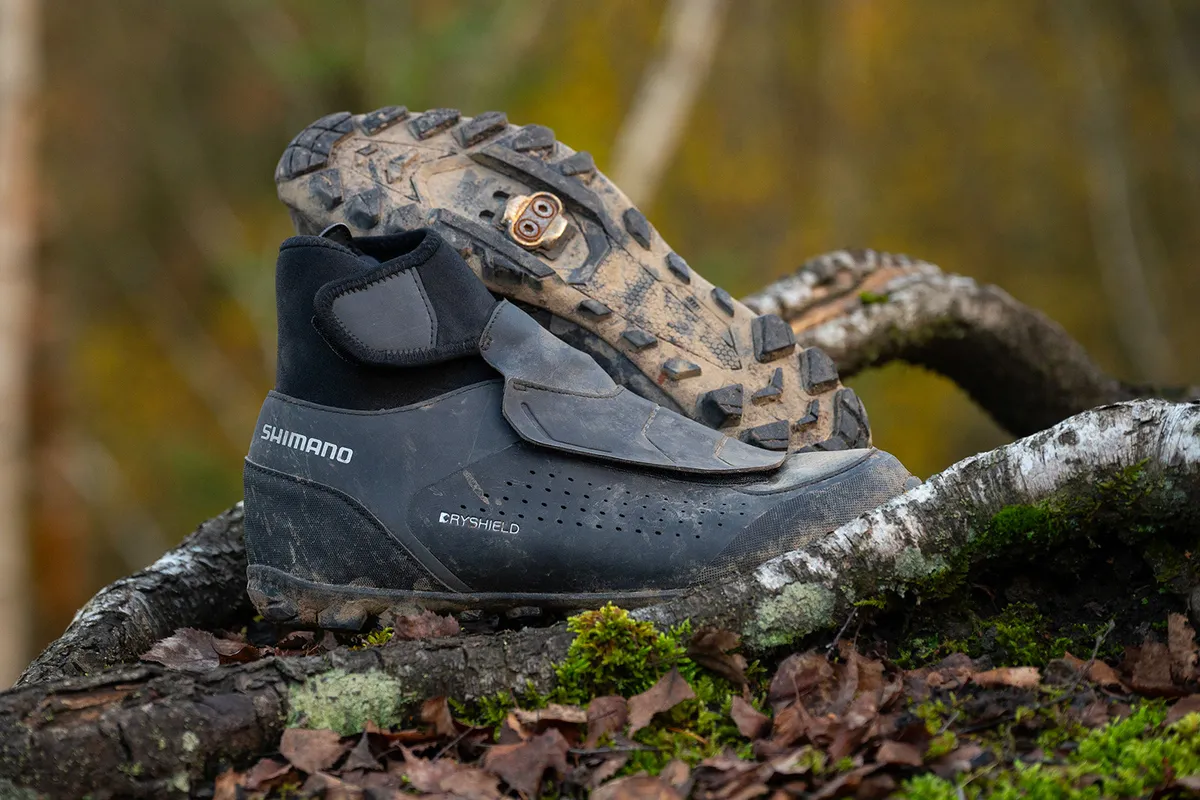
- £140 as tested
- Cleat type: MTB cleat
- Pros: Good levels of waterproofing; very comfortable
- Cons: Not the warmest
Shimano’s lower-spec winter boots use the brand’s own ‘DRYSHIELD’ membrane (not the Gore-Tex of the MW7s), but still keep your feet dry on all but the soggiest rides.
The fleece lining provides warmth without too much bulk, but when the mercury drops they aren't as warm as other options.
These shoes have a good fit and a sole that isn’t overly rigid or harsh. The cuff is shorter than ideal, but fits under riding trousers – if they reach – and is secured with Velcro.
There’s a flap to protect the speedlace system, which also provides an additional barrier against water ingress.
Ease of pedal entry and exit is good, and while they don’t have the most cleat setback here, it’s enough even for aggressive riding.
The sole provides fair off-bike grip and is one of the comfiest on the trail.
SQUIRREL_13188995
Shimano MW7 MTB
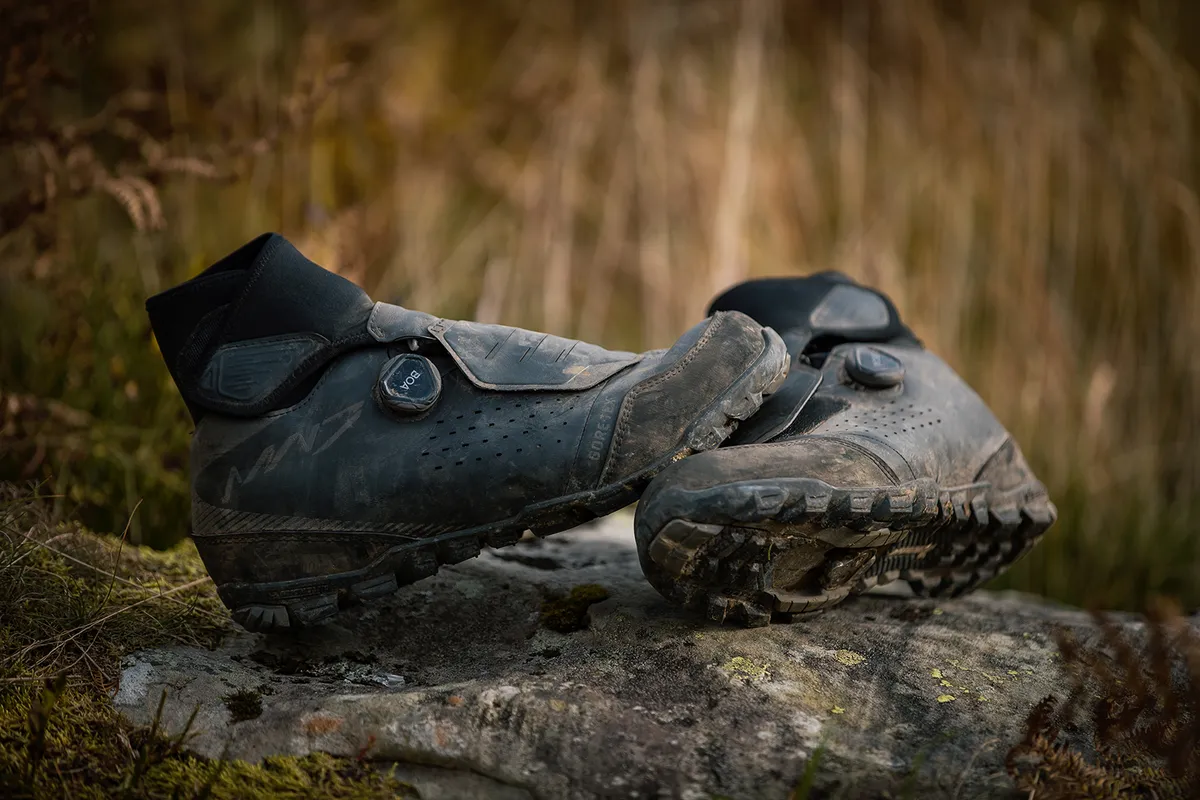
- £189.99 / $275 / €242 as tested
- Cleat type: MTB cleat
- Pros: Gore-Tex lining for great wind and water resistance; warm and comfortable
- Cons: Heavy rain overcomes waterproofing
The MW7s are Shimano’s top-of-the-range winter riding shoes and they offer performance to match, keeping your feet happy in pretty terrible winter conditions.
They’re designed for SPD pedals, but you can still use them on a road bike – you just need the right pedals. Even roadies will appreciate the chunky, grippy sole for when you need to get off the bike at any point.
They have a Gore-Tex lining that means the upper is essentially waterproof and windproof, although they will get overwhelmed eventually if you’re out for hours. The integrated lace shield also stops the Boa closure from becoming overwhelmed with mud when you’re off-road.
SQUIRREL_13078265
Also consider…
The following winter cycling shoes scored fewer than four stars in our reviews, but are still worth considering.
EKOI Perf W4 Boa

- £377 / $395 / €350 as tested
- Cleat type: Road cleat
- Pros: Very warm; stiff sole; often discounted
- Cons: Narrow fit; water ingress through ankle cuff; very expensive at full list price
If your rides are more cold than wet, EKOI's winter boots may be for you. There's a mix of a single Boa dial and Velcro cuff to keep your feet in place and the interiors include both waterproofing and insulation. The three-bolt outsole is made of polyamide with 15 per cent carbon fibre and is as stiff as many performance road shoes.
We found the toe box a little narrow, so we'd recommend sizing up. The low cuff also allows water to seep in on wetter rides. The list price is very high for a winter shoe, although EKOI often offers deep discounts, so you may find the Perf W3 Boa with a much more affordable price tag.
SQUIRREL_13088453
Northwave Celsius R Arctic GTX
SQUIRREL_TEXT_13108646
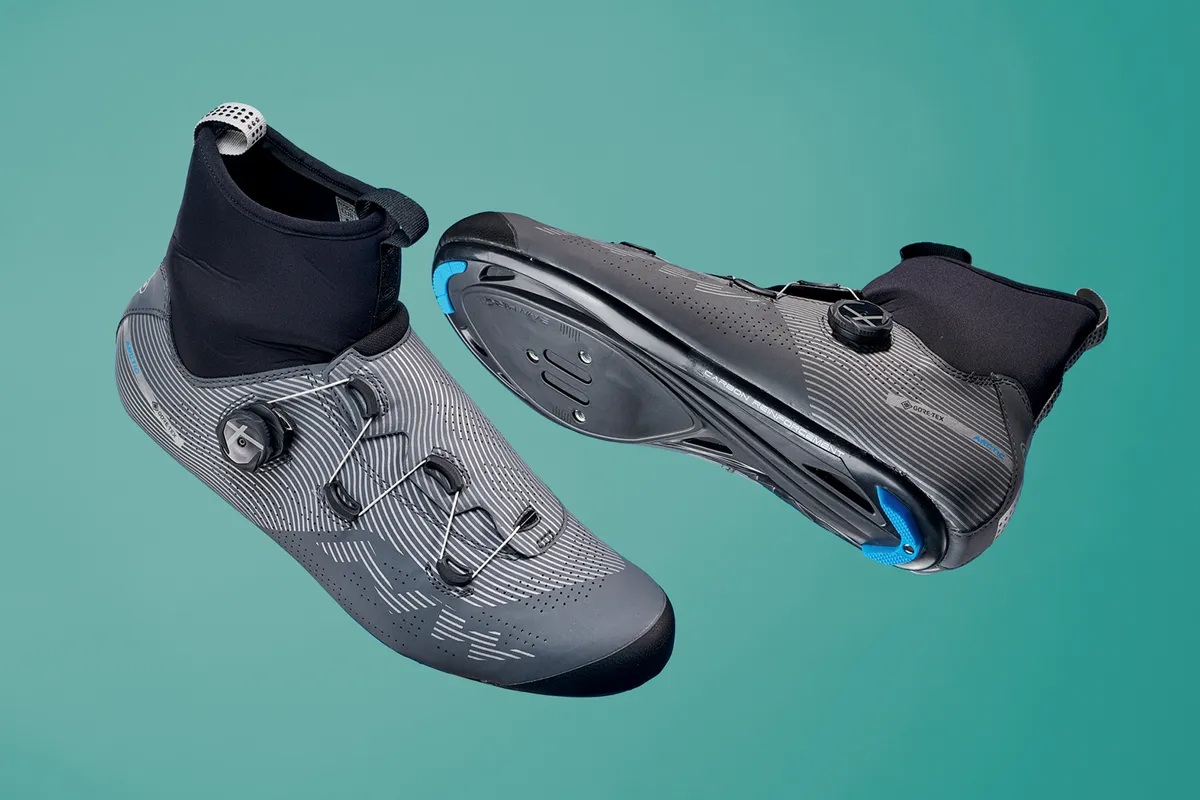
- £210 / $280 / €250 / AU$378 as tested
- Cleat type: Road cleat
- Pros: Comfortable; fully waterproof uppers
- Cons: Collar can leak in heavy downpours
We found Northwave's Celsius R Arctic GTX boots to be luxuriously soft and comfortable, with a lovely fleece lining that kept our tootsies warm, even with thin socks.
However, the SLW2 dials were really fiddly to use with thick gloves and suffered from water ingress around the neoprene collar.
SQUIRREL_13108646
Shimano MW702
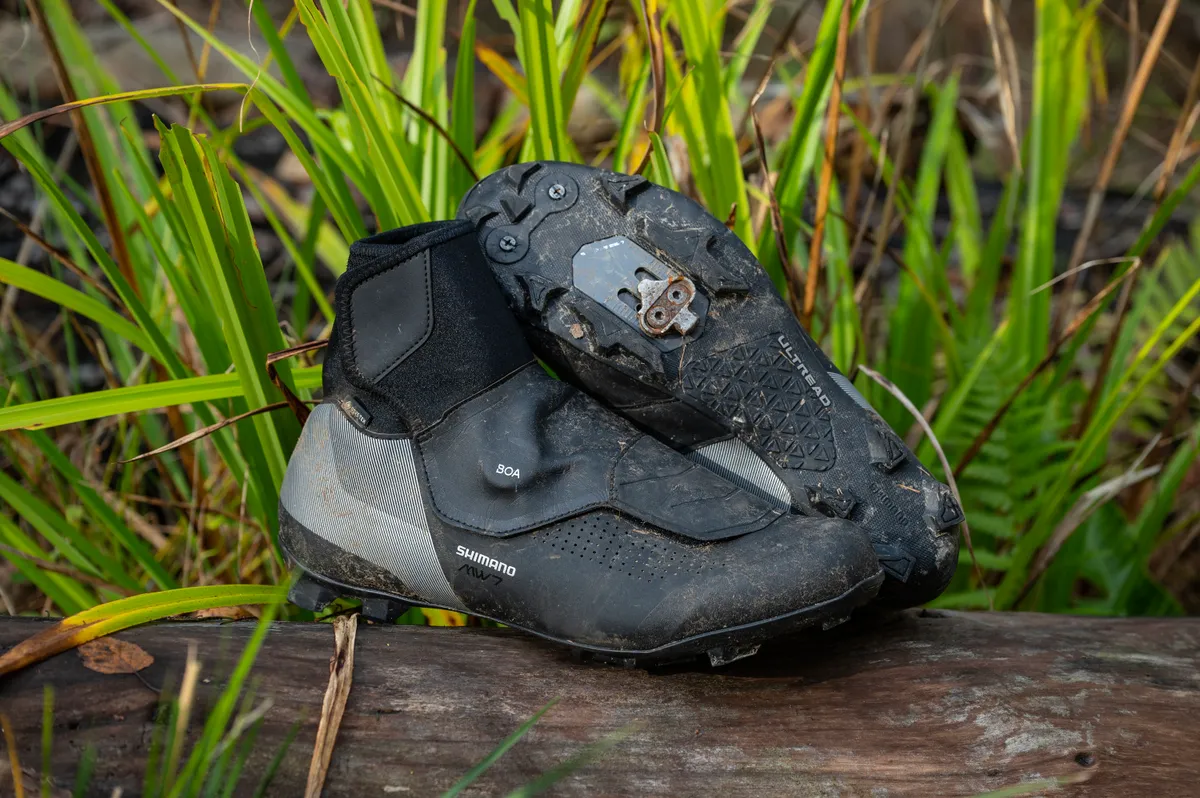
- £230.95 / $274.33 / €230.95
- Cleat type: MTB cleat
- Pros: Boa dial provides a good fit; generous internal room
- Cons: Not the best heel-hold; some pressure points when cranked tight
The MW702 is the latest iteration of Shimano's MW7 shoe, and is built around a chunky XC sole with a hint of toe flex to assist with walking.
A Gore-Tex liner in the upper and a neoprene sleeve help keep water at bay, and also protect the Boa dial from wheel spray.
The shoe is let down partially by pressure points in the fit and a loose heel-hold.
SQUIRREL_13078173
Sidi Nix

- £299 / $298 / €269 as tested
- Cleat type: Road cleat
- Pros: Great in cold weather; roomy
- Cons: Water ingress through ankle cuff; whole sizes only
The Sidi Nix shoes stand out in blue and yellow, although there are also options in black or white. There's a Gore-Tex ePE membrane sandwiched between the tough TPU outer and PrimaLoft insulation.
The shoes are closed with a Tecno 4 dial and that broad yellow Velcro strap. Sidi's sole is stiff enough for efficient pedalling, while still allowing you to flex your feet.
Sidi makes the Nix in whole sizes only and there's a little extra room, which is useful in a winter shoe. There's plenty of warmth and the uppers are waterproof, although as with other winter boots with a low cuff, water runs down the leg into the tops, wetting feet and the ankle cuff.
SQUIRREL_13189010
Fizik Tempo Artica GTX
SQUIRREL_TEXT_13083060
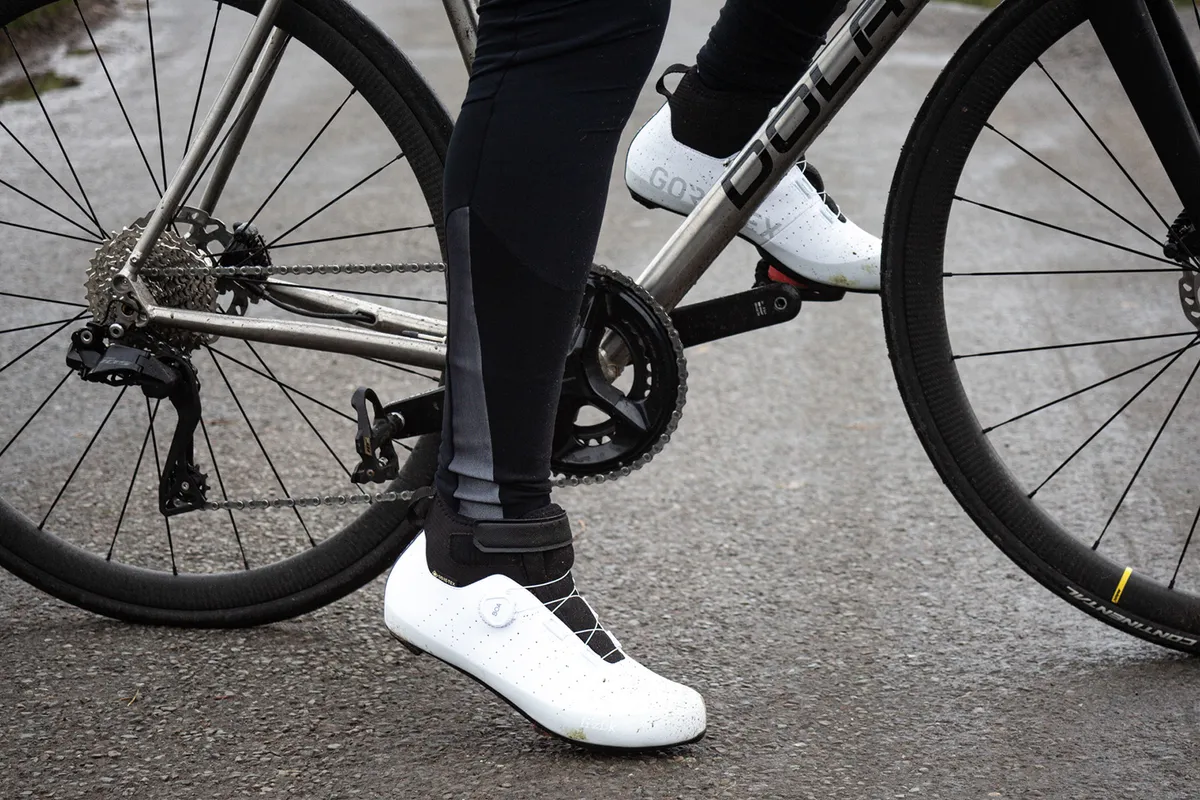
- £250 / $260 / €259 as tested
- Cleat type: Road cleat
- Pros: Comfortable; generous sizing for winter socks
- Cons: Collar can seep water into the shoe
The Fizik Tempo Artica GTX winter cycling shoe is a step down in quality from its predecessor, the Artica R5.
Although insulation is ample to keep your feet warm in low temperatures, waterproofing is inconsistent.
The upper of the shoe is impermeable, but water running down your leg seeps in through the top. This meant our tester had to wear them with overshoes in the rain, which is an inconvenience you're trying to avoid.
SQUIRREL_13083060
How we test winter cycling shoes
There's no substitute for riding when it comes to testing winter cycling shoes, and that needs to be in cold wet conditions. So we're out in the worst of the winter weather finding out how winter shoes cope with rain and temperatures heading down to freezing. Each pair is tested over multiple rides over an extended time period, so we can assess how they bear up, how quickly they dry out and more. What do we look for?
- Fit – are the shoes comfortable in our size or do we need to size up or down? Can we fit thicker winter socks? Do they rub?
- Warmth – how do feet feel after a ride of several hours?
- Waterproofing – are socks and feet dry after a ride in the rain?
- Weight – how does this compare to the competition?
- Size range – are smaller, larger and wider feet accommodated?
- Price – how does price compare to other winter cycling shoes?
Why you can trust BikeRadar
BikeRadar has been an authority on bikes and cycling tech since its inception in 2007, delivering the world’s best riding advice.
We have experts testing all types of bikes, parts, clothing and accessories, from road, mountain and gravel bikes to commuting, bikepacking and electric bikes.
Our reviews are always editorially independent – with no exceptions. Our reviewers comprehensively test all products in the real world, always reflecting on performance, value and the wider market when delivering their verdicts and review ratings.
We have more than 15,000 product reviews available at your fingertips, as well as expert buying, maintenance, training, skills, health and fitness advice.
Our annual Bike of the Year test is an industry benchmark and the BikeRadar team consists of some of the most experienced riders and testers in the business.
Winter cycling shoes buyer's guide
Do you need winter cycling shoes?
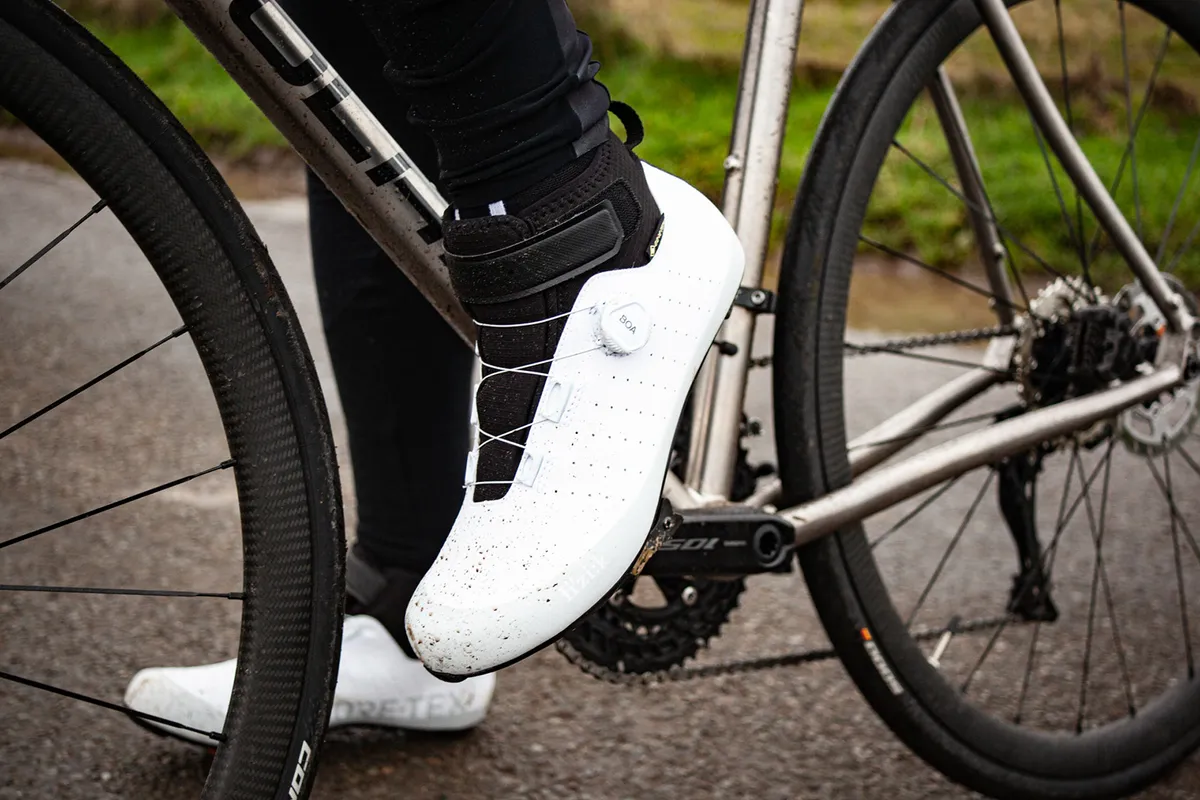
It depends. Do you get cold feet while cycling in the winter and how much does it bother you?
If the answer to those two questions is ‘no’ and ‘not much’, then you probably don’t need winter cycling shoes.
In milder parts of the world, for example, the best overshoes will keep your lovely disco slippers clean, and your feet dry and fairly warm.
If your answers to the above questions are ‘yes’ and ‘a lot’, it’s likely you could benefit greatly from a pair of dedicated winter cycling shoes.
Not only are they more likely to keep your feet warm and dry in the harshest conditions, the best winter cycling shoes are also considerably more durable than overshoes, many of which begin to fall apart the instant they come into contact with the ground.
There's also the 'hassle factor'. Getting ready for a winter ride can become a chore if you've got countless layers to pull on – winter cycling shoes can remove the inconvenience often associated with overshoes.
If overshoes will meet your demands, why not check out our lists of the best road cycling shoes and the best mountain bike shoes.
Weatherproofing
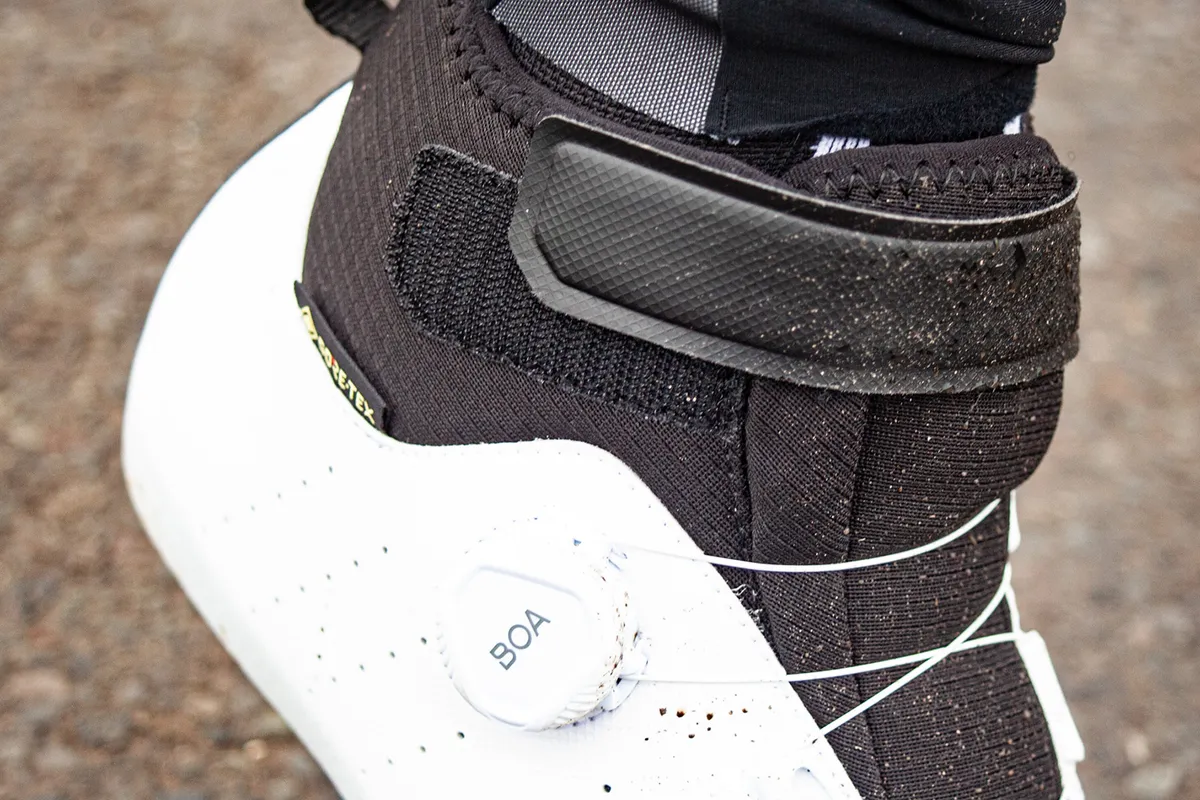
It’s not only chilly temperatures and the wind that make your feet cold in winter. Wet conditions are a real problem, too, so the key to a good pair of winter cycling shoes is weatherproofing and added insulation.
Look for shoes with Gore-Tex or other waterproof membranes built into the uppers. Just like with waterproof jackets for cyclists, these fabrics help make shoes waterproof, windproof and breathable (the last of which is important to avoid sweat building up on the inside and eventually making feet cold).
However, while winter shoes are designed to keep rain out, the cuff sometimes acts as a weak spot for water ingress.
Insulation, through the addition of thicker, fleecy fabrics, and a lack of ventilation in the uppers, is also important because you want to trap heat within the shoe, rather than let it escape to the outside air.
Soles
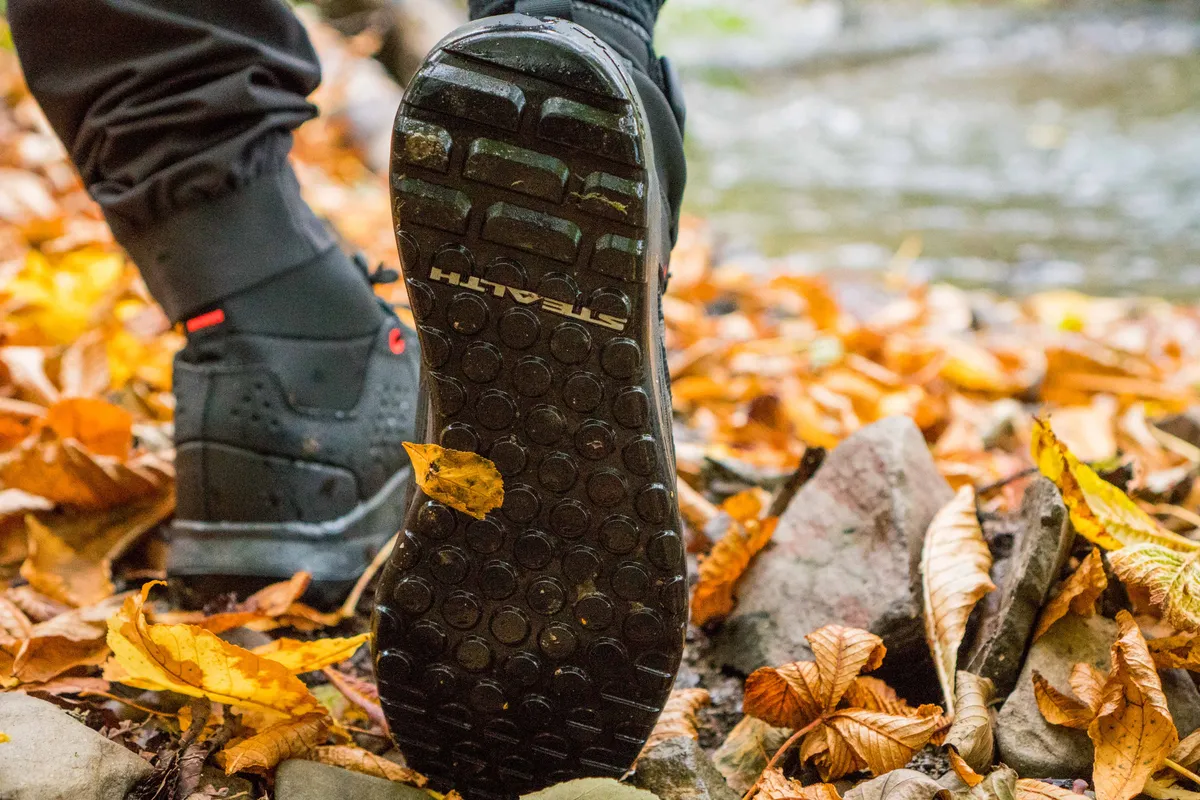
Winter-specific cycling shoes tend to have a more flexible sole than race-dedicated summer shoes, and while you might be giving up a couple of watts when really cranking on the pedals, you’ll appreciate the extra comfort over the course of a long ride or whenever you have to get off the bike and walk.
If you’re a dedicated road rider, then a shoe with a road sole (i.e. one without any tread and designed to accommodate a road cleat) will do fine and often go better with the sleek look of your road kit.
But if there’s any chance of going off-road, or even just on rough or icy surfaces, then the grippy tread present on an MTB-style sole is a real boon – you don’t want to have to resort to walking on road cleats during the winter. Even a coffee stop on slippery wet floors can be hazardous with smooth soles.
Road or MTB cleat?
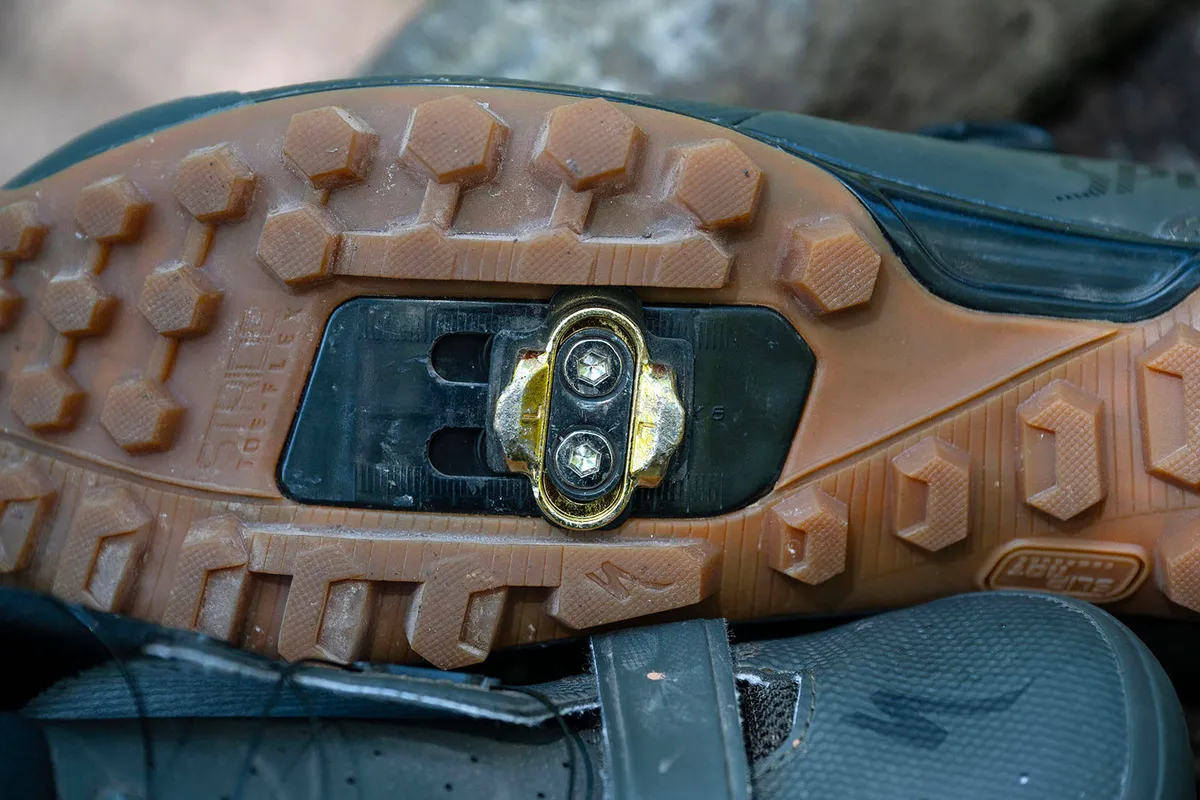
Similar to the previous point about soles and tread, it’s easy to assume that if you ride a road bike you should get shoes that are compatible with road cleats, and though these will be fine on cold, dry rides on nice roads, for everything else, it's worth considering mountain bike cleats.
Though they usually mean a smaller, marginally less stable platform than road pedals, MTB cleats and compatible shoes often have a number of advantages over road shoes, that come into their own during the winter.
Concepts such as tread and mud clearance aren’t things most roadies usually have to pay much attention to, but come across a slippery section of road or an overly muddy farm track that you just can’t traverse on your road bike, and you’ll instantly regret having to climb off and shuffle delicately over the obstacle in your road shoes.
If you want a more in-depth look at the difference between road and MTB pedals and cleat systems, check out our guide on how to use clipless pedals.
Fit
While you usually want a pair of summer cycling shoes to fit snugly with thin, lightweight socks, a little extra room for warm socks can be invaluable in winter shoes.
Many brands build in this extra room as standard, meaning you might be able to just go with your normal size, but this isn’t always the case.
As always with shoes, it’s worth visiting a shop in person or ordering from a retailer with a good returns policy, so you can try them on for size with the kind of socks you’re likely to want to wear while riding.
Other features
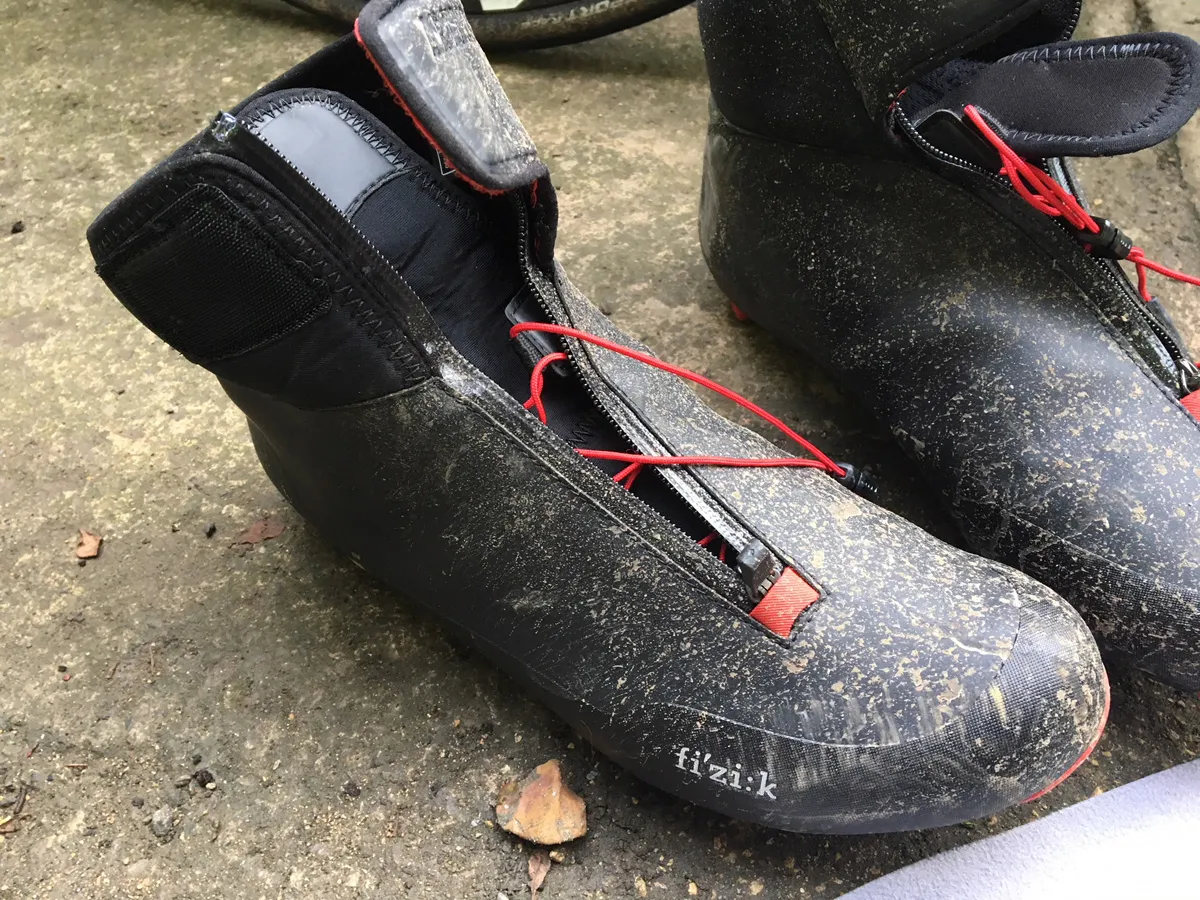
One of the most important areas of a winter cycling shoe is the ankle cuff. A well-designed cuff should fit snugly to help keep out wind and water, while still enabling you to get the shoes on and off without too much trouble.
While it might also add a little weight and bulk, a tall cuff that extends a bit further up your calf will also add a bit more protection and enable you to utilise one of BikeRadar staffers' most beloved tricks: putting the end of your tights over the top of the cuff of the shoe or overshoes.
The idea is that water will run off the bottom of the tight and onto the outside of the shoe, rather than soaking down the inside of the cuff and into your socks. It's not necessarily a great look, we'll admit, but if you can get over that, it works very well.
